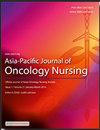Multivariable prediction of returning to work among early-onset colorectal cancer survivors in China: A two-year follow-up
IF 2.8
3区 医学
Q1 NURSING
引用次数: 0
Abstract
Objective
The number of early-onset colorectal cancer survivors (EOCRCs) is increasing. The primary aim of rehabilitation after battling cancer is to enable patients to return to work, as they constitute a significant contributor to societal productivity. A predictive model was developed to identify priority populations requiring intervention and refine responses to increase their capacity to return to work after undergoing treatment for EOCRC.
Methods
The baseline information was collected before patients were discharged at the end of their treatment course. The data of patients who returned to work were collected at 1 and 2 years after discharge. A predictive variable model was developed via binary logistic regression. The TRIPOD checklist was used.
Results
At 1 year, 64.7% of the EOCRC survivors had returned to work. Male sex, education, return to work self efficacy, re-entry readiness and social support increased the possibility of returning to work; higher levels of self-perceived fatigue and lower levels of family care decreased the possibility of returning to work within the 1-year model. At 2 years, 72.8% of the EOCRC survivors had returned to work. In the 2-year model, education, self-transcendence, return to work self efficacy, re-entry readiness and occupational environment increased the possibility of returning to work; self-perceived fatigue and psychosocial adjustment decreased the possibility of returning to work.
Conclusions
The results of this study can guide early assessment and intervention for EOCRC survivors, to facilitate their return to work.
中国早发性结直肠癌幸存者重返工作岗位的多变量预测:一项为期两年的随访
目的:早期结直肠癌幸存者(eoccs)的数量在不断增加。战胜癌症后康复的主要目的是使患者能够重返工作岗位,因为他们是社会生产力的重要贡献者。开发了一个预测模型,以确定需要干预的重点人群,并改进应对措施,以提高他们在接受EOCRC治疗后重返工作岗位的能力。方法在患者疗程结束出院前收集基线资料。在出院后1年和2年收集重返工作岗位的患者资料。通过二元逻辑回归建立预测变量模型。使用了TRIPOD检查表。结果1年后,64.7%的EOCRC幸存者重返工作岗位。男性性别、受教育程度、重返工作自我效能、重返工作准备和社会支持增加了重返工作的可能性;较高水平的自我感知疲劳和较低水平的家庭护理降低了1年内重返工作岗位的可能性。2年后,72.8%的EOCRC幸存者重返工作岗位。在2年模型中,教育程度、自我超越、重返工作自我效能、再就业准备和职业环境增加了重返工作的可能性;自我感觉疲劳和心理社会调整降低了重返工作岗位的可能性。结论本研究结果可指导EOCRC幸存者的早期评估和干预,促进其重返工作岗位。
本文章由计算机程序翻译,如有差异,请以英文原文为准。
求助全文
约1分钟内获得全文
求助全文
来源期刊

Asia-Pacific Journal of Oncology Nursing
Multiple-
CiteScore
2.80
自引率
11.10%
发文量
136
审稿时长
31 days
 求助内容:
求助内容: 应助结果提醒方式:
应助结果提醒方式:


